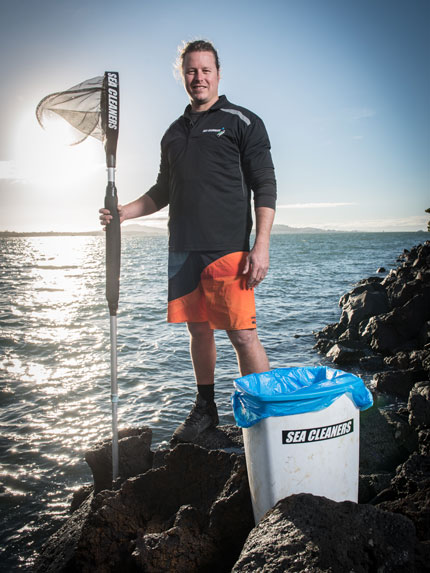Hayden Smith, Sea Cleaners

No human in the world today will live to see an ocean free of plastic.
It’s a sobering fact. Our sea is clogged with plastic waste: from our coastlines to the vast open convergence zones in the middle of the oceans.
But it’s not like one giant island of rubbish, says Hayden Smith from Auckland-based trust, Sea Cleaners.
“It’s more like a fog strewn through all of our oceans and waterways. Every plastic item that’s ever been made still exists. It’s a very real problem which, unfortunately, is out of sight so out of mind for the general population.”
Hayden however, sees the problem firsthand and he’s doing something about it. Five days a week, he and his crew, backed by a growing team of volunteers, scour Auckland’s coastlines for the waste that so many people carelessly toss away. “Each morning at first light we’re down at the marina. The day’s location depends on what the wind and tide are doing, but we’ll go ashore and collect rubbish off the shoreline. When we find rubbish floating in the sea, we’ll scoop that up too.”
It sounds simple, and it is, Hayden says. But it’s the scale that’s the real problem.
“Each vessel and crew collect about a shipping container full of rubbish each month – it works out to between 10 and 12 shipping containers per year for each crew,” Hayden says. “Every rubbish bag we collect equals 50 litres. Since we started we’ve pulled out over 4.5 million litres of rubbish from our waterways.”
Sea Cleaners began back in 2000. Hayden was working as a kayak guide in Auckland, taking groups out to Rangitoto Island. One day when bad weather cancelled the tours, he took a kayak out by himself. “I set off under the Harbour Bridge, straight into the howling sou'-wester. Suddenly I was surrounded by all this rubbish washing down through the convergence zones in the upper harbour. I’d never seen anything like it before.
I thought: ‘I have to do something about this!’”
And so he did.
After lots of door knocking and cold-calling, Hayden eventually convinced the then five mayors of Auckland to sponsor his initiative, and for the last 15 years he has been working with teams of volunteers to clean up the Waitemata, Manukau and Whangarei harbours.
“Our focus is around the main population centres. That’s where the rubbish is, that’s where the volunteers are and that’s where the communities are that can help us,” he says.
Sea Cleaners is focused on marine litter: primarily plastic trash. “From chip packets and lolly wrappers, to drink bottles, car tyres and polystyrene – you name it, we’ve found it,” Hayden says. “90% of what we collect comes off the land through the stormwater systems. Heavy rain cleans the streets and washes everything into the sea. The ocean is downhill from everywhere, so that’s where it’s always going to go.”
But the ocean has no borders, and with its perpetual system of currents, plastic waste can potentially travel around the whole planet. “We started wondering about what was happening to the rubbish that doesn’t end up on Great Barrier Island as it leaves Auckland.”
Wanting to find out more, he made contact with Captain Charles Moore, the man who discovered the Great Pacific Garbage Patch. “It’s in the northern Pacific ocean, north of Hawaii. It’s a giant eddy, called a gyre – a big circulating vortex of ocean currents.
“In 2009, I chartered a seaplane to go out with Charlie to this gyre. What we saw from the air was the most convincing evidence of the scale of the problem: there were these convergence zones – very similar to what I had seen under Auckland Harbour Bridge – with long lines of debris, like rivers, that stretched from one horizon to the next, lined up one after another as far as the eye could see.”
As horrifying as this sounds, Hayden was not discouraged. “I began to recognise the value of what we were doing. Seeing the volume of rubbish we were removing on a daily basis, I realised we were actually contributing to less rubbish coming into this particular space. For me, it was a real driver to do the multiplication process and focus our efforts on our own city centres.”
By 2020 Sea Cleaners’ goal is to have ten boats running in New Zealand, and they’re just about there already. A key sponsor, the Bobby Stafford-Bush Foundation, has recently donated seven new boats on top of Sea Cleaners’ existing three.
“Once we have all ten crews up and running, we’ll know how to deploy these boats in blocks of ten. The next step is to set up in ten countries around the Pacific, with ten boats in each country using what we’ve done in New Zealand as the pilot model.”
With momentum and awareness beginning to build, the last two years have been pretty monumental for Sea Cleaners, and for Hayden personally. In 2016 he was instrumental in arranging a coastal clean-up in Hawaii with the naval forces from 28 nations, including USA and New Zealand.
This February he was acknowledged as a Local Hero in the Kiwibank New Zealander of the Year Awards, and in April, also in Hawaii, Hayden was involved in setting up the Ocean Aid music festival.
Hayden hopes to continue the Sea Cleaners’ mission of raising awareness for this very real, global problem.
“The greatest thing that I would like to see happen would be for each person across the whole population to pick up one piece of trash each day. Imagine having 4.5 million people, every day, picking up just one piece of rubbish – whether it’s on the verge outside their house, or walking through a school ground or going for a walk on the beach – just that one piece. Getting that mass support is what we need to do.”
Reported by Jo Percival for our AA Directions winter 2017 issue
